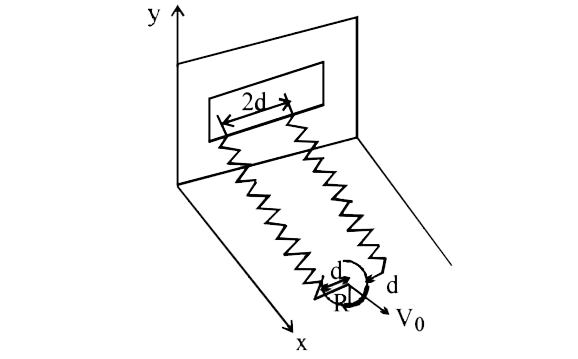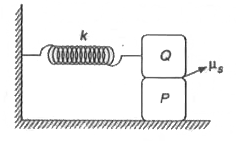A block P of mass m is placed on horizontal frictionless plane. A second block of same mass m is placed on it and is connected to a spring of spring constant k, the two blocks are pulled by distance A. Block Q oscillates without slipping. What is the maximum value of frictional force between the two blocks.
 Solution in Gujrati
Solution in Gujrati
(a)kA
(b)kA2
(c)zero
(d)μsmg
The correct Answer is:B
Block Q oscillates but does not slipe on P. It mean that acceleration is same for Q and P both. There is a force of friction between the two blocks while the horizontal plane is frictinless. The spring is connected to upper block. The (P-Q) system oscilaltes with angular frequency ω. The spring is streactched by A.
∴ω=√km+m=√k2m
∴ Maximum acceleration in SHM =ω2A
am=kA2m.......(i)
Now consider the lower block.
Let the maximum force of friction =fm
∴fm=mam⇒fm=m×kA2m⇒fm=kA2
Topper's Solved these Questions
- SIMPLE HARMONIC MOTIONBOOK - ALLEN CHAPTER - SIMPLE HARMONIC MOTIONEXERCISE - MCQ s one or more than one correct answers
5 Videos
- SIMPLE HARMONIC MOTIONBOOK - ALLEN CHAPTER - SIMPLE HARMONIC MOTIONEXERCISE - Paragraph
3 Videos
- SIMPLE HARMONIC MOTIONBOOK - ALLEN CHAPTER - SIMPLE HARMONIC MOTIONEXERCISE - Exercise-05 [A]
39 Videos
- RACEBOOK - ALLEN CHAPTER - RACEEXERCISE - Basic Maths (Wave Motion & Dopplers Effect) (Stationary waves & doppler effect, beats)
25 Videos
- TEST PAPERBOOK - ALLEN CHAPTER - TEST PAPEREXERCISE - PHYSICS
4 Videos
Similar Questions
Three simple harmonic motions in the same direction having the same amplitude and same period are superposed. If each differ in phase from the next by 45∘, then
View SolutionA uniform thin cylindrical disk of mass M and radius R is attaached to two identical massless springs of spring constatn k which are fixed to the wall as shown in the figure. The springs are attached to the axle of the disk symmetrically on either side at a distance d from its centre. The axle is massless and both the springs and the axle are in horizontal plane. the unstretched length of each spring is L. The disk is initially at its equilibrium position with its centre of mass (CM) at a distance L from the wall. The disk rolls without slipping with velocity →V0=vacV0ˆi. The coefficinet of friction is μ.

The net external force acting on the disk when its centre of mass is at displacement x with respect to its equilibrium position is.
View SolutionIf a spring has time period T, and is cut into (n) equal parts, then the time period of each part will be.
View SolutionThe frequency of a radar is 780 MHz. After getting reflected from an approaching aeroplane, the apparent frequency is more than the actual frequency by 2.6 kHz. The aeroplane has a speed of
View SolutionChoose the correct statement:
View SolutionA block of mass m is connected to another block of mass M by a spring (massless) of spring constant k. The block are kept on a smooth horizontal plane. Initially the blocks are at rest and the spring is unstretched. Then a constant force F starts acting on the block of mass M to pull it. Find the force of the block of mass M.
View SolutionTwo spring are connected toa block of mass M placed a frictionless surface as shown if both the spring have a spring constant k the frequency of oscillation block is
View SolutionA block Q of mass 2m is placed on a horizontal frictionless plane. A second block of mass m is placed on it and is connected to a spring of spring constant K, the two block are pulled by distance A. Block Q oscillates without slipping. The work done by the friction force on block Q when the spring regains its natural length is:
View SolutionA block of mass 'm' is connected to another block of mass 'M' by a spring (massless) of spring constant 'k' The blocks are kept on a smooth horizontal plane. Initially the blocks are at rest and the spring is unstretched Then a constant force 'F' starts acting on the block of mass 'M' to pull it. Find the force on the block of mass 'm' :
View SolutionA block P of mass m is placed on a smooth horizontal surface. A block Q of the same mass is placed over the block P and the coefficient of static friction between them is mu . A spring of spring constant K is attached to block Q. The blocks are displaced together to a distance A and released. The upper block oscillates without slipping over the lower block. The maximum frictional force between the block is:
View Solutionद्रव्यमान के एक ब्लॉक को द्रव्यमान M के दूसरे ब्लॉक में स्प्रिंग नियतांक की स्प्रिंग ( द्रव्यमान नगण्य ) द्वारा जोड़ दिया जाता है । ब्लॉक एक चिकने समतल पर रखे हुए हैं । प्रारंभ में ब्लॉक स्थिर है तथा स्प्रिंग सामान्य स्थिति में है, तब द्रव्यमान M के ब्लॉक को एक नियत बल f द्वारा खींचा जाता है । द्रव्यमान m के ब्लॉक पर आरोपित बल होगा -
View Solutionm द्रव्यमान का एक ब्लॉक P क्षैतिज चिकने समतल पर रखा है। समान द्रव्यमान m का एक दूसरा ब्लॉक Q इस पर रखा है तथा स्प्रिंग नियतांक k की एक स्प्रिंग से जुड़ा है। दोनों ब्लॉक दूरी A से विस्थापित किए जाते हैं। ब्लॉक Q बिना फिसले दोलन करता है। दोनों ब्लॉकों के मध्य घर्षण बल का अधिकतम मान है

View SolutionA block Q of mass 2m is placed on a horizontal frictionless plane. A second block of mass m is placed on it and is connected to a spring of spring constant K, the two block are pulled by distance A. Block Q oscillates without slipping. The work done by the friction force on block Q when the spring regains its natural length is
View SolutionA block of mass 'm' is connected to another block of mass 'M' by a spring (massless) of spring constant 'k'. The blocks are kept on a smooth horizontal plane. Initially the blocks are at rest and the spring is unstretched. Then a constant force 'F' starts acting on the block of mass 'M' to pull it. Find the force on the block of mass 'm'.
View SolutionA block P of mass m is placed on a horizontal frictionless plane. A second block of same mass m is placed on it and is connected to a spring of spring constant K, the two blocks are pulled by distance A. Block Q oscillates without slipping. The maximum value of frictional force between blocks is

View SolutionA block of mass m is connected to another block of mass M by a spring (massless) of spring constant k. The blocks are kept on a smooth horizontal plane. Initially the blocks are at rest and the spring is unstretched. Then a constant force F starts acting on the block of mass M to pull it. Find the force on the block of mass m.
View Solution
